
Churches - Bevendean History Project

St Cuthman's New Church, WhitehawkPeople
remembered that the Church was originally white but during the Second
World War the church building was bombed. Significantly sticking
out of the rubble was the large crucifix which had hung inside the
church at the front. This was subsequently put into the next
church building which was completed in 1952 and dedicated in 1953.
The new church was built between 1951 and 1952 by John Leopold Denman.
FOUNDATION STONE LAYING
The Foundation stone of the new St. Cuthman’s Church, Whitehawk, was laid on Saturday 14 July 1951 by Mr. C. A. Wilson.
The service was conducted by the Bishop of Lewes assisted by the Vicar of Brighton and the Vicar of St. Cuthman’s (Rev. J. J. Smith).
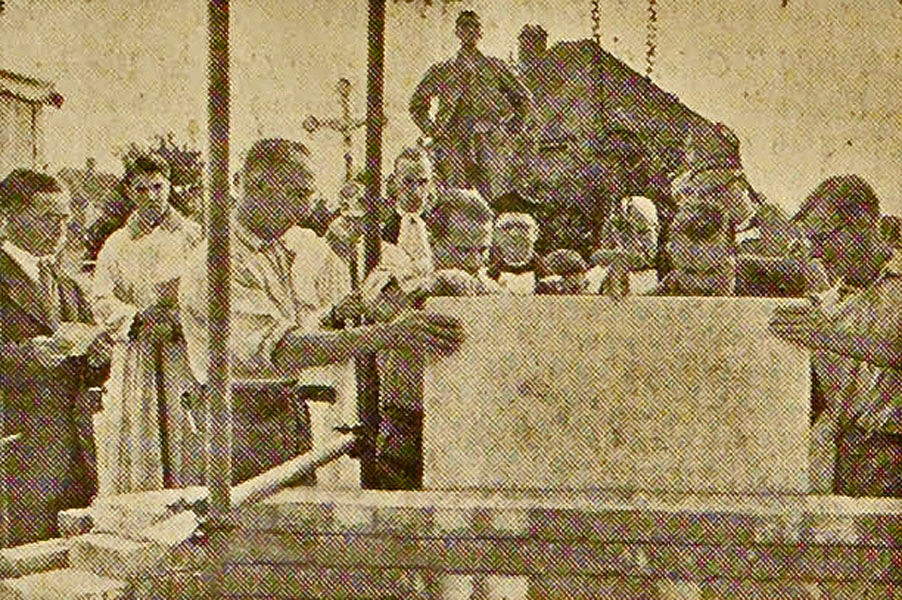
Image Source: Brighton and Hove Herald 21 July 1951
THE NEW ST. CUTHMAN'S RISES AT WHITEHAWK
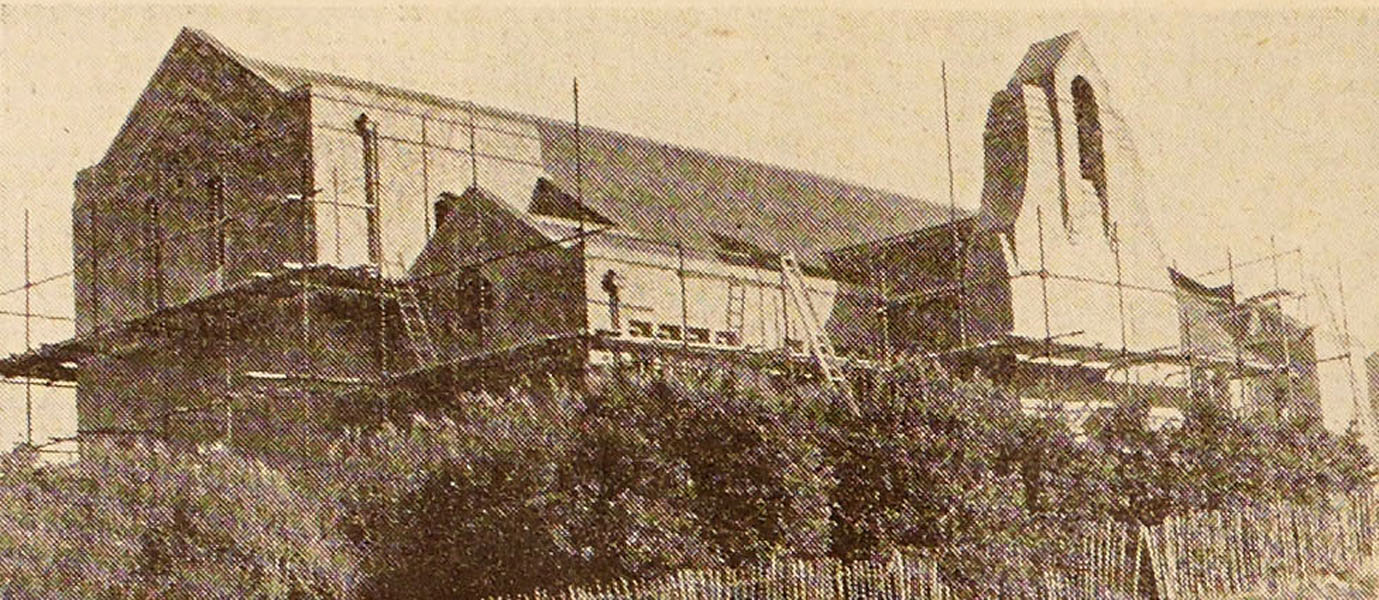
Image Source: Brighton and Hove Herald date 1 March 1952
A report from The Brighton Herald reads “A large, graceful building has arisen in the centre of the Whitehawk Council Estate—the new Church of St Cuthman's, to replace the old church, bombed in the war.
The new building, designed by Mr John L. Denman, is entirely different in appearance from the old St, Cuthman's. The main entrance is from Twineham Road and Lintott Avenue, which does away with the need for the long flight of steps which was a feature of the old church.
The consecration ceremony of the new St, Cuthman's will be performed by the Bishop of Chichester (Dr. G. K. A- Bell), on 14 June 52, and a week of church activities will follow.
Services will be conducted by the Bishop of Lewes (the Rt. Rev. Geoffrey H. Warde) and the Bishop of Woolwich (the Rt Rev. R. William Stannard).
While workmen are completing the fabric of the building, the vicar (the Rev. J. J. Smith), with Miss J. Stanley, is busy at work on the enamelling and paintwork of the altar.
The new church will cost £15,386, with a hall beneath the building three times the size of the old one. Seating and stained glass windows from St. James's Church, now demolished, will be installed”.
A plan of the new church dated January 1951 drawn by Denman and Son.
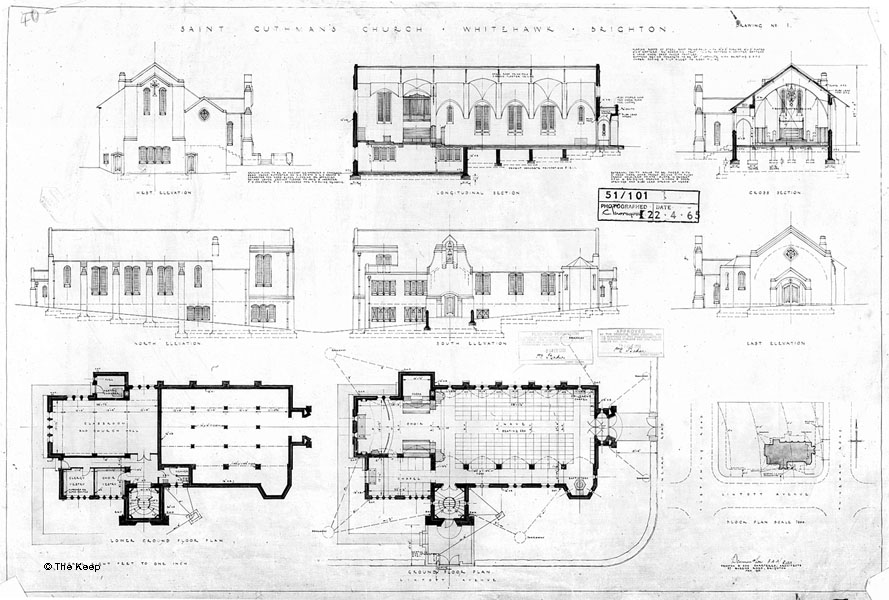
Keep Ref: DB/D/139/51/1/101
The Consecration of the New St Cuthman's Church as reported in the Brighton and Hove Herald on 21st June 1952.
NEW ST. CUTHMAN'S IS A CHALLENGE
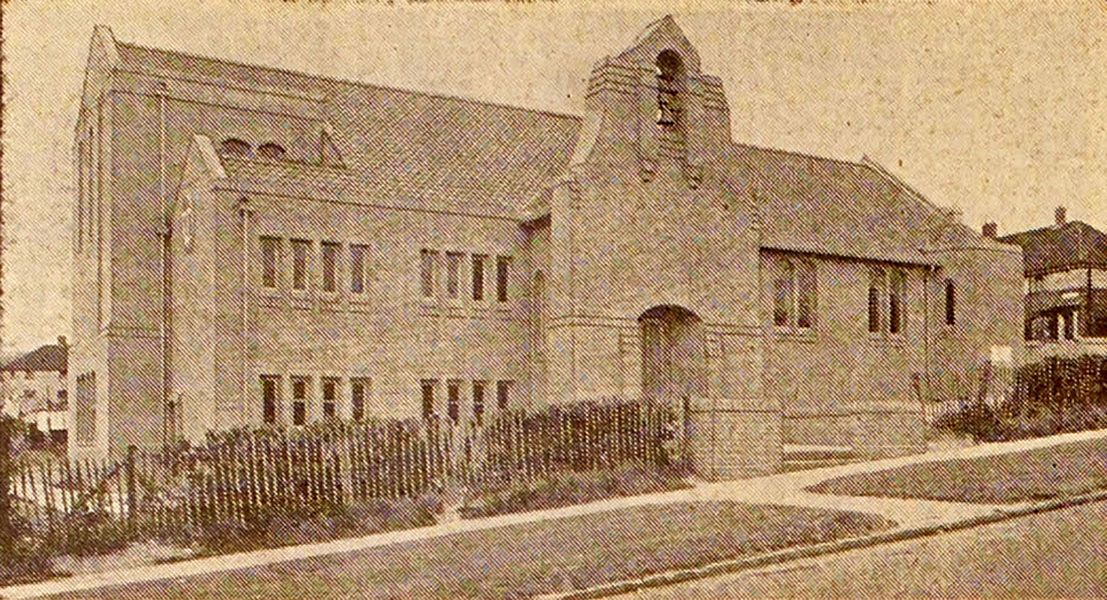
Image Source: Brighton and Hove Herald date 21 June 1952.
Almost nine years after a bomb reduced St Cuthman's Church to rubble, a new church has at last been built, and there was an impressive ceremony on Saturday when a large congregation filled the church in Lintott Avenue, Whitehawk. to overflowing for the service of consecration conducted by the Bishop of Chichester (Dr. G. K. A. Bell).
After paying tribute to the way the people of Whitehawk stood the strain of the war years. Dr. Bell said the rebuilding of the bricks and timber of St. Cuthman's is a symbol of the rebuilding of the nation's life on spiritual foundations.
"It is a challenge for all here to go out and tell Whitehawk people of the true foundations of life and the kinship of God." he added, “Devastation and world suicide lie ahead unless nations change their minds and the hearts of men within the nations are transformed."
The Prime Minister, said Dr. Bell, had sounded the alert, which is also an alarm, by saying that the peril we face today is as grave as that which faced the country during the war.
“These words are relevant to most ASPECTS of our life and the hard truth is that the peril we FACE today cannot be overcome on the material plane,” SAID Dr. Bell, “It is the SPIRITUAL transformation for which this church STANDS which IS indispensable.”
Those taking part in the service, which was attended by the Mayor of Brighton (Alderman Miss D. Stringer), were the Archdeacon of Lewes (the Venerable J. H. L. Morrell), the Vicar of Brighton (Canon F. N. Robathan, O.B.E.), the Vicar of St. Anne's, Kemp Town (Canon T. J. James, M.C.), the Vicar of St. Bartholomew's (Canon C. W. Hutchinson), and the former Vicar of St. Cuthman's (the Rev. C. P. Bryan).
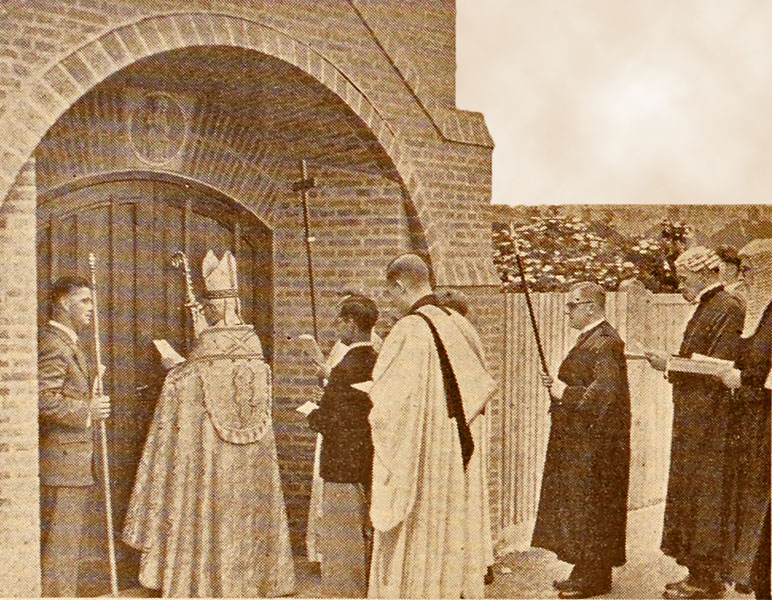
The Bishop of Chichester, leading the procession, knocks on tghe door of the new church during the impressive Consecration ceremony.
Image Source: Brighton and Hove Herald date 21 June 1952.
Lintott Avenue, Whitehawk
Lintott Avenue was built in the 1930s, and was misspelt on the 1938 OS map. It was named after Alderman John Lintott, a builder and surveyor and a member of the council's housing sub-committee, who built numerous properties in East Brighton.
Lintott Avenue was just to the south of St Cuthman's Church and was removed in the reconfiguration of the Whitehawk estate in 1973.
A footpath now runs down the slope where Lintott Avenue once ran from Whitehawk Way to Cooksbridge Road.
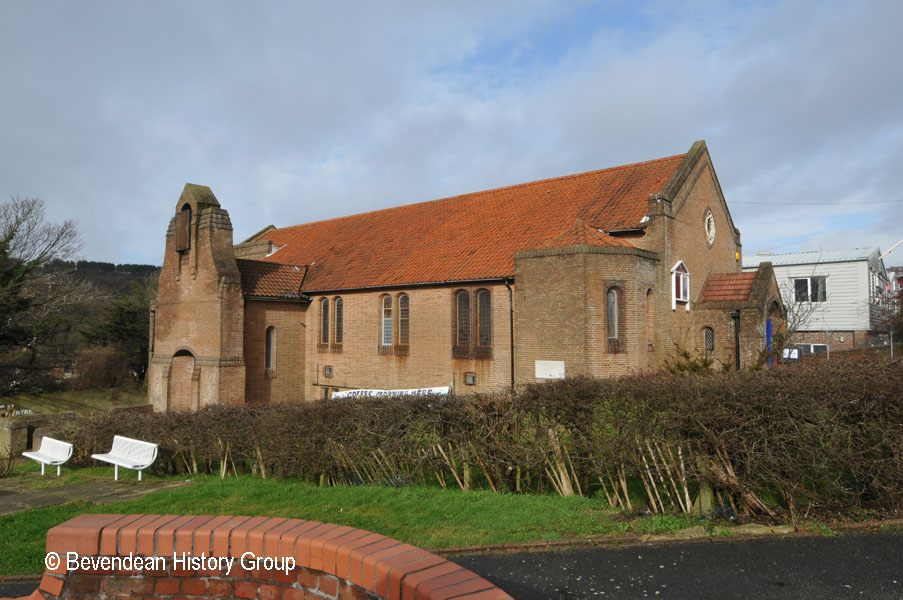
St Cuthman’s Church viewed from Whitehawk Way in February 2011.
BHG Ref: 2011-02-12_DSC_1582
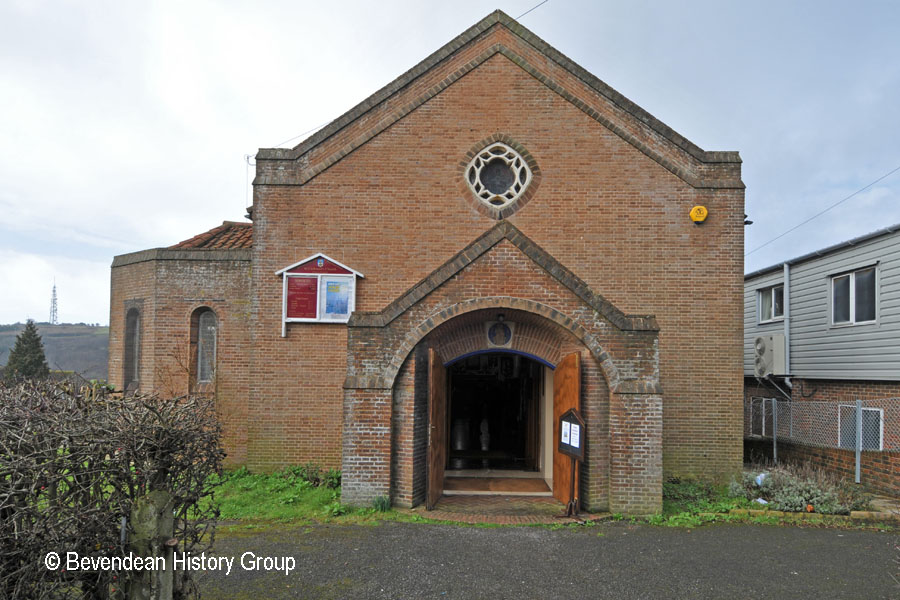
St Cuthman’s Church main entrance from Whitehawk Way in February 2011.
BHG Ref: 2011-02-12_DSC_1588
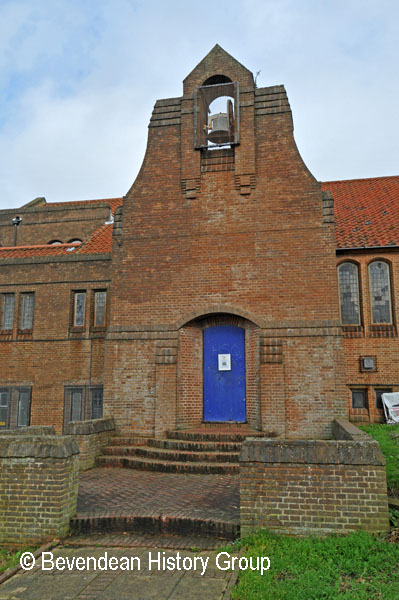
St Cuthman’s Church Bell Tower in February 2011.
BHG Ref: 2011-02-12_DSC_1576
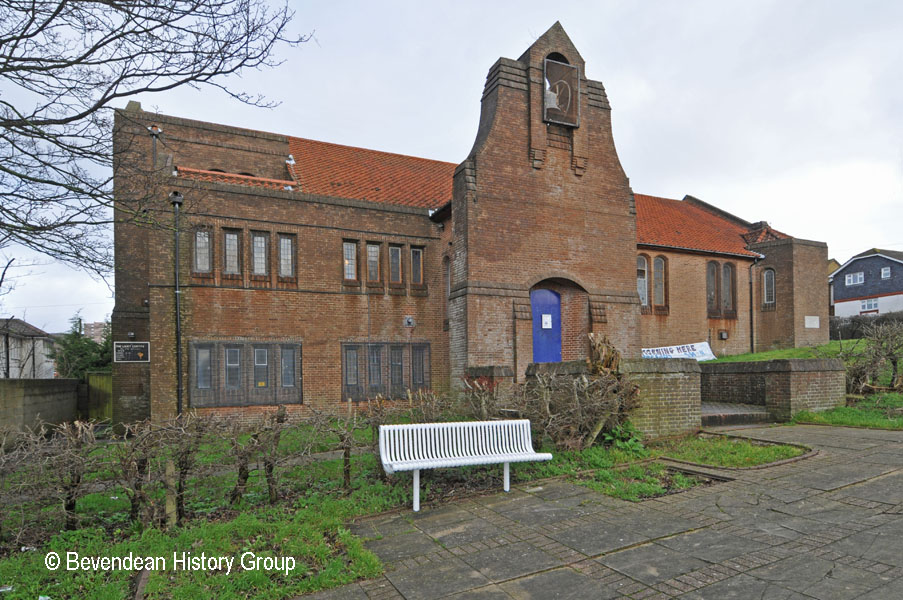
St Cuthman’s Church South Side in February 2011.
BHG Ref: 2011-02-12_DSC_1578
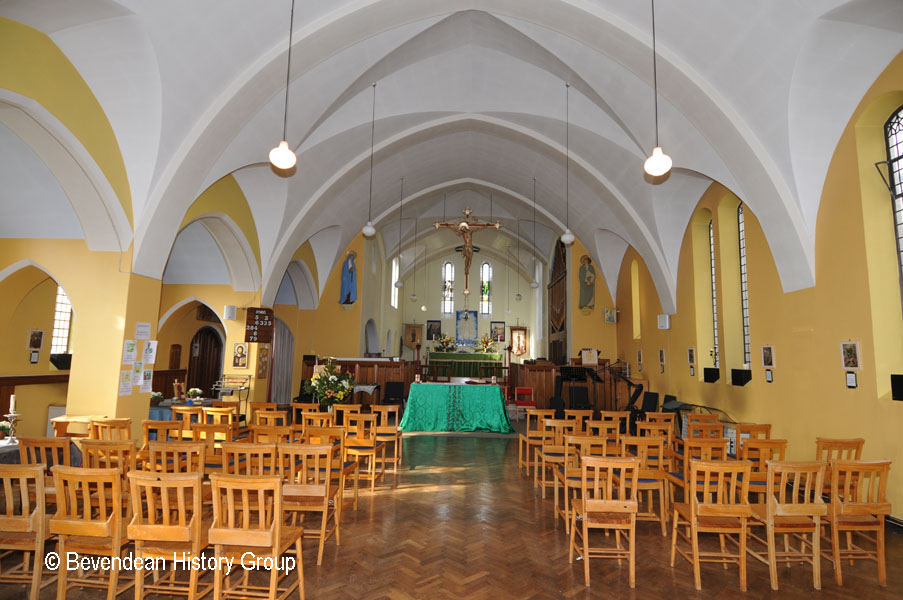
St Cuthman’s Church interior view towards the Sanctuary in February 2011.
BHG Ref: 2011-02-12_DSC_1600
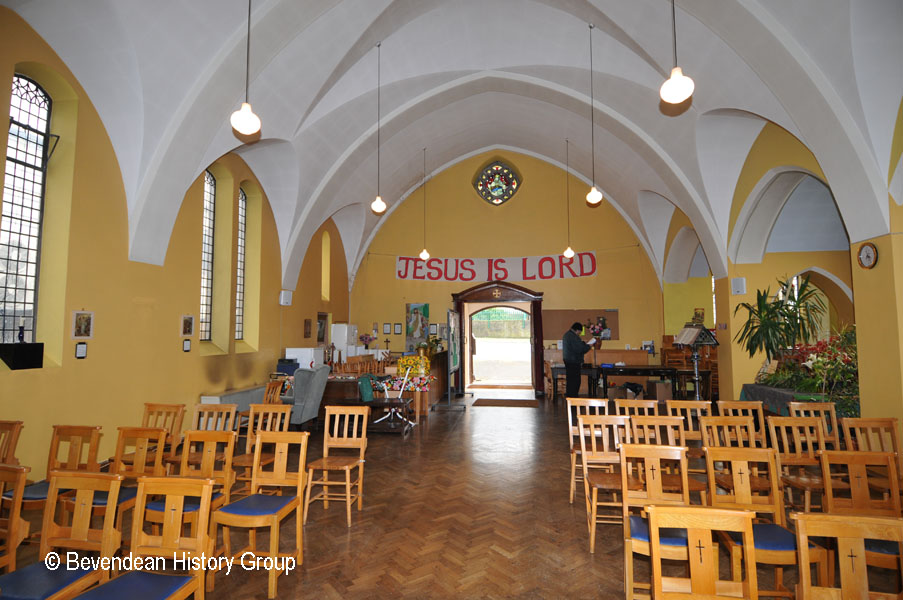
St Cuthman’s Church interior view towards main entrance in February 2011.
BHG Ref: 2011-02-12_DSC_1589
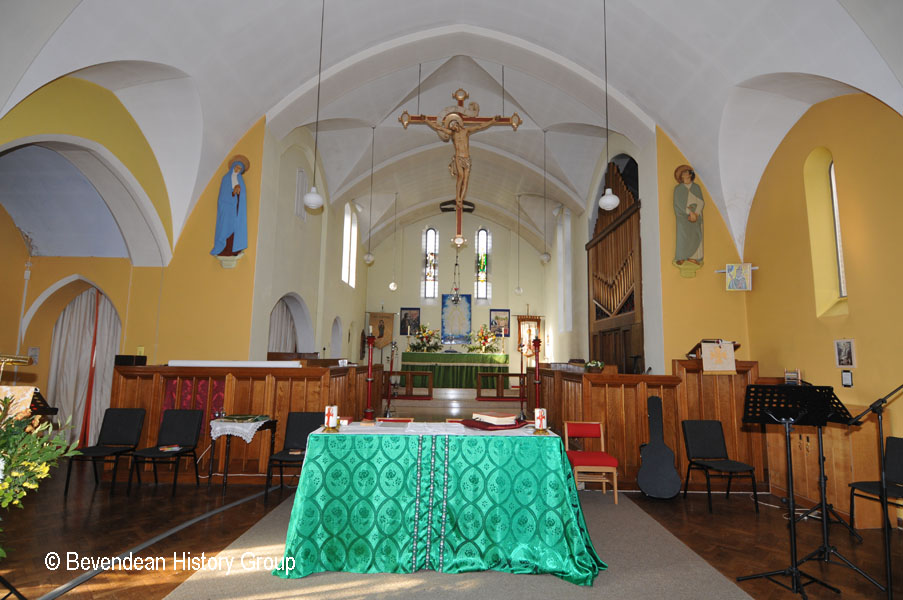
St Cuthman’s Church interior view of from the Nave towards the Altar in February 2011.
BHG Ref: 2011-02-12_DSC_1599
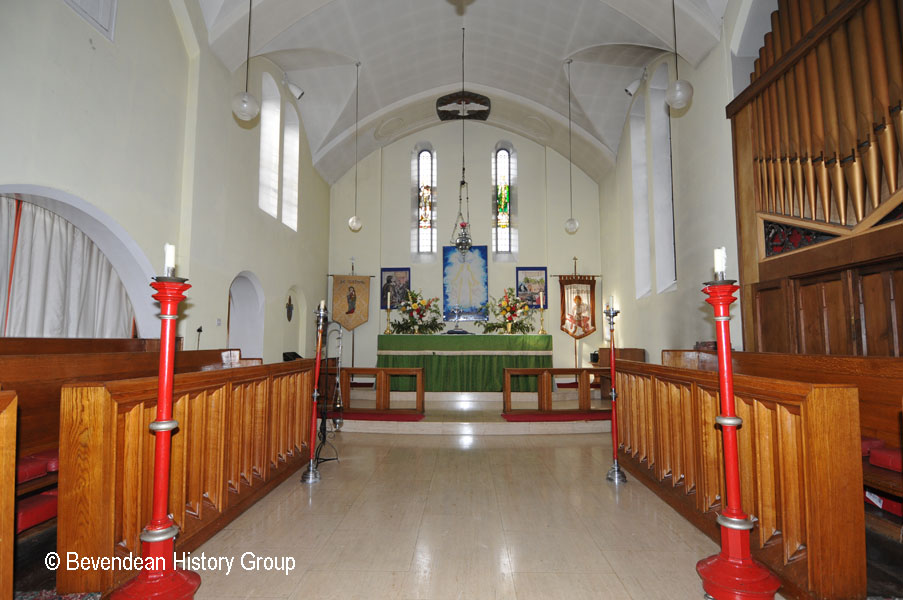
St Cuthman’s Church interior view of choir and altar in February 2011.
BHG Ref: 2011-02-12_DSC_1595
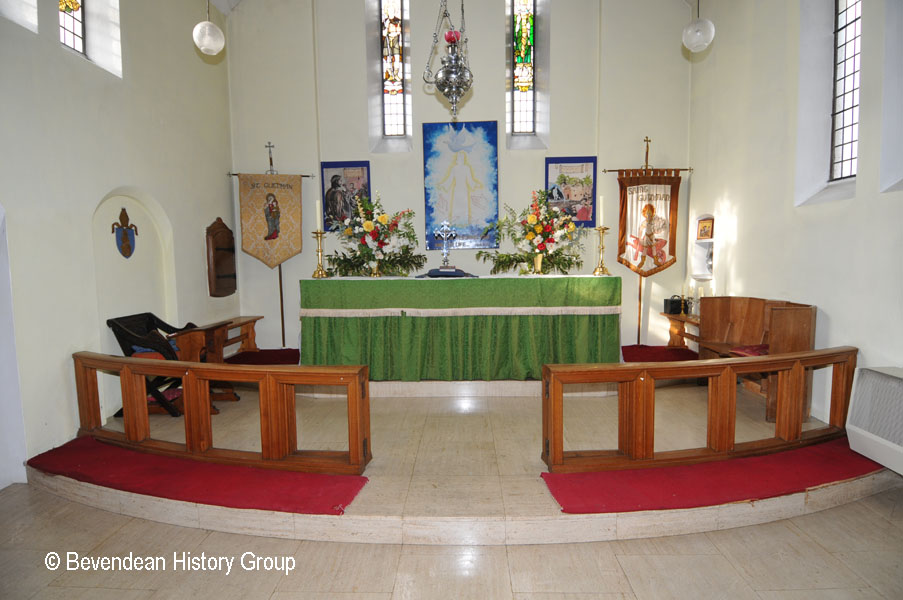
St Cuthman’s Church interior view of sanctuary and altar in February 2011.
BHG Ref: 2011-02-12_DSC_1596
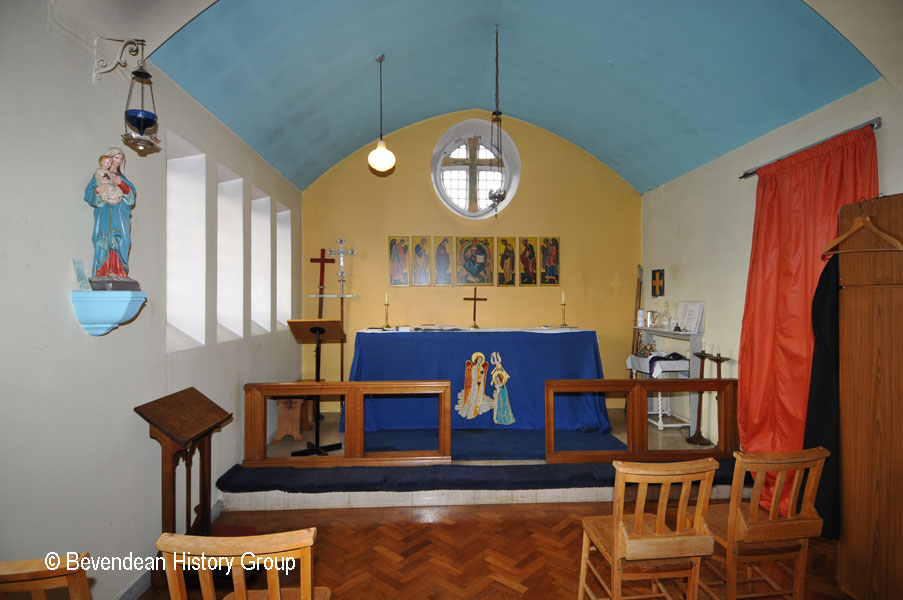
St Cuthman’s Church view of Lady Chapel in February 2011.
BHG Ref: 2011-02-12_DSC_1591
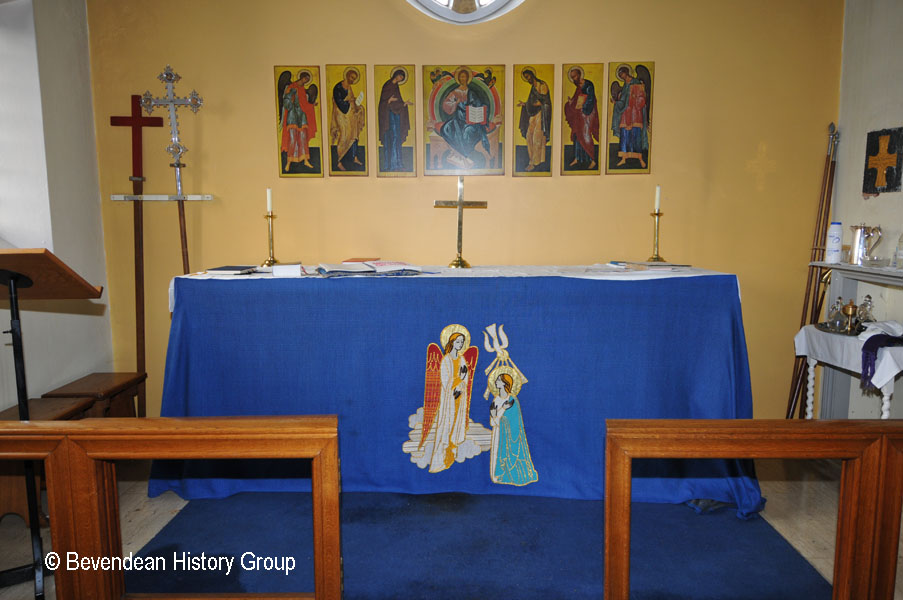
St Cuthman’s Church Altar in Lady Chapel in February 2011.
BHG Ref: 2011-02-12_DSC_1592
ST CUTHMAN'S CHURCH HALL
Plans for a Church Hall were drawn by Denman and Son in 1962 and approved on the 6th November 1962.
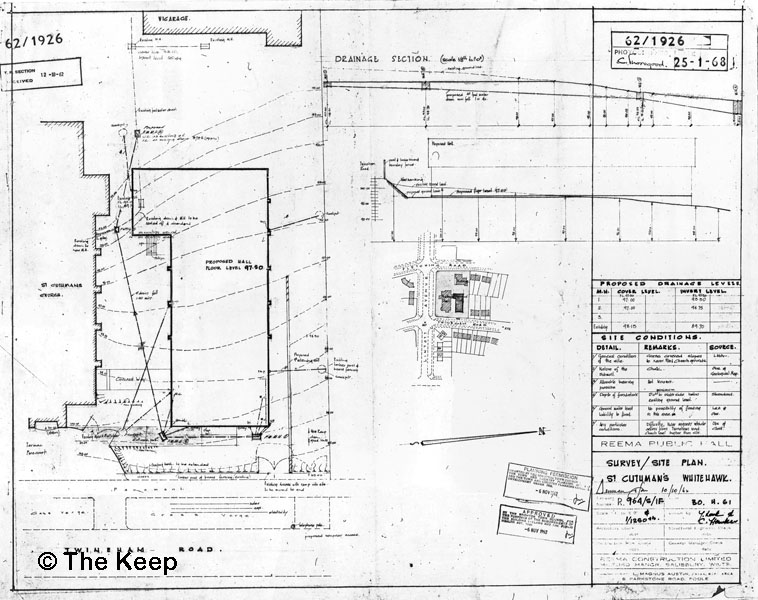
Church Hall site plan approved 6 November 1962, drawn by Denman and Son.
Keep Ref: DB-D-139-62-3-1926
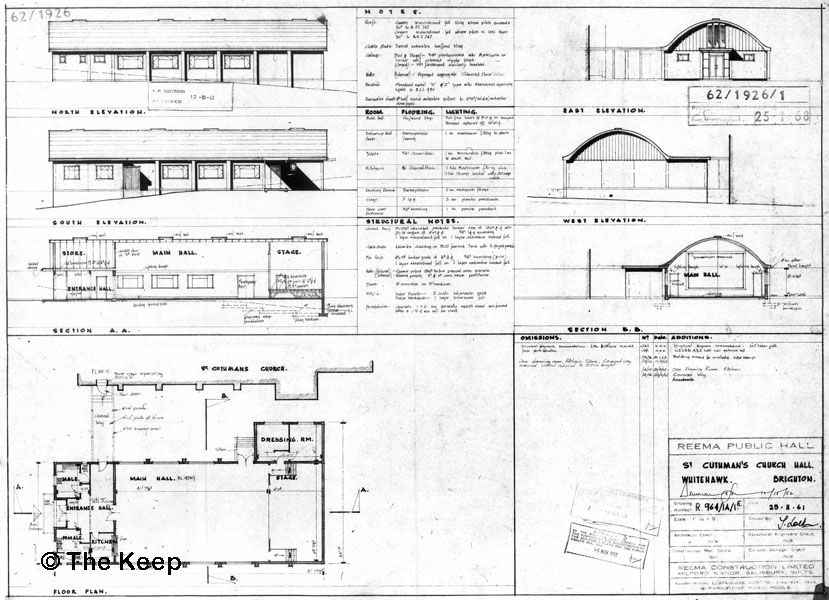
Church Hall plan approved 6 November 1962 drawn by Denman and Son.
Keep Ref: DB/D/139/62/3/1926/1
The church hall was sold to the Community Association in 1982 to become the Valley Social Centre. It has subsequently been altered and expanded. In 2023 its future is currently under discussion.
Photographs and plans of the churches
The new church was built between 1951 and 1952 by John Leopold Denman.
FOUNDATION STONE LAYING
The Foundation stone of the new St. Cuthman’s Church, Whitehawk, was laid on Saturday 14 July 1951 by Mr. C. A. Wilson.
The service was conducted by the Bishop of Lewes assisted by the Vicar of Brighton and the Vicar of St. Cuthman’s (Rev. J. J. Smith).

Image Source: Brighton and Hove Herald 21 July 1951
THE NEW ST. CUTHMAN'S RISES AT WHITEHAWK

Image Source: Brighton and Hove Herald date 1 March 1952
A report from The Brighton Herald reads “A large, graceful building has arisen in the centre of the Whitehawk Council Estate—the new Church of St Cuthman's, to replace the old church, bombed in the war.
The new building, designed by Mr John L. Denman, is entirely different in appearance from the old St, Cuthman's. The main entrance is from Twineham Road and Lintott Avenue, which does away with the need for the long flight of steps which was a feature of the old church.
The consecration ceremony of the new St, Cuthman's will be performed by the Bishop of Chichester (Dr. G. K. A- Bell), on 14 June 52, and a week of church activities will follow.
Services will be conducted by the Bishop of Lewes (the Rt. Rev. Geoffrey H. Warde) and the Bishop of Woolwich (the Rt Rev. R. William Stannard).
While workmen are completing the fabric of the building, the vicar (the Rev. J. J. Smith), with Miss J. Stanley, is busy at work on the enamelling and paintwork of the altar.
The new church will cost £15,386, with a hall beneath the building three times the size of the old one. Seating and stained glass windows from St. James's Church, now demolished, will be installed”.
A plan of the new church dated January 1951 drawn by Denman and Son.

Keep Ref: DB/D/139/51/1/101
The Consecration of the New St Cuthman's Church as reported in the Brighton and Hove Herald on 21st June 1952.
NEW ST. CUTHMAN'S IS A CHALLENGE

Image Source: Brighton and Hove Herald date 21 June 1952.
Almost nine years after a bomb reduced St Cuthman's Church to rubble, a new church has at last been built, and there was an impressive ceremony on Saturday when a large congregation filled the church in Lintott Avenue, Whitehawk. to overflowing for the service of consecration conducted by the Bishop of Chichester (Dr. G. K. A. Bell).
After paying tribute to the way the people of Whitehawk stood the strain of the war years. Dr. Bell said the rebuilding of the bricks and timber of St. Cuthman's is a symbol of the rebuilding of the nation's life on spiritual foundations.
"It is a challenge for all here to go out and tell Whitehawk people of the true foundations of life and the kinship of God." he added, “Devastation and world suicide lie ahead unless nations change their minds and the hearts of men within the nations are transformed."
The Prime Minister, said Dr. Bell, had sounded the alert, which is also an alarm, by saying that the peril we face today is as grave as that which faced the country during the war.
“These words are relevant to most ASPECTS of our life and the hard truth is that the peril we FACE today cannot be overcome on the material plane,” SAID Dr. Bell, “It is the SPIRITUAL transformation for which this church STANDS which IS indispensable.”
Those taking part in the service, which was attended by the Mayor of Brighton (Alderman Miss D. Stringer), were the Archdeacon of Lewes (the Venerable J. H. L. Morrell), the Vicar of Brighton (Canon F. N. Robathan, O.B.E.), the Vicar of St. Anne's, Kemp Town (Canon T. J. James, M.C.), the Vicar of St. Bartholomew's (Canon C. W. Hutchinson), and the former Vicar of St. Cuthman's (the Rev. C. P. Bryan).

The Bishop of Chichester, leading the procession, knocks on tghe door of the new church during the impressive Consecration ceremony.
Image Source: Brighton and Hove Herald date 21 June 1952.
Lintott Avenue, Whitehawk
Lintott Avenue was built in the 1930s, and was misspelt on the 1938 OS map. It was named after Alderman John Lintott, a builder and surveyor and a member of the council's housing sub-committee, who built numerous properties in East Brighton.
Lintott Avenue was just to the south of St Cuthman's Church and was removed in the reconfiguration of the Whitehawk estate in 1973.
A footpath now runs down the slope where Lintott Avenue once ran from Whitehawk Way to Cooksbridge Road.

St Cuthman’s Church viewed from Whitehawk Way in February 2011.
BHG Ref: 2011-02-12_DSC_1582

St Cuthman’s Church main entrance from Whitehawk Way in February 2011.
BHG Ref: 2011-02-12_DSC_1588

BHG Ref: 2011-02-12_DSC_1576

St Cuthman’s Church South Side in February 2011.
BHG Ref: 2011-02-12_DSC_1578

St Cuthman’s Church interior view towards the Sanctuary in February 2011.
BHG Ref: 2011-02-12_DSC_1600

St Cuthman’s Church interior view towards main entrance in February 2011.
BHG Ref: 2011-02-12_DSC_1589

St Cuthman’s Church interior view of from the Nave towards the Altar in February 2011.
BHG Ref: 2011-02-12_DSC_1599

St Cuthman’s Church interior view of choir and altar in February 2011.
BHG Ref: 2011-02-12_DSC_1595

St Cuthman’s Church interior view of sanctuary and altar in February 2011.
BHG Ref: 2011-02-12_DSC_1596

St Cuthman’s Church view of Lady Chapel in February 2011.
BHG Ref: 2011-02-12_DSC_1591

St Cuthman’s Church Altar in Lady Chapel in February 2011.
BHG Ref: 2011-02-12_DSC_1592
ST CUTHMAN'S CHURCH HALL
Plans for a Church Hall were drawn by Denman and Son in 1962 and approved on the 6th November 1962.

Church Hall site plan approved 6 November 1962, drawn by Denman and Son.
Keep Ref: DB-D-139-62-3-1926

Church Hall plan approved 6 November 1962 drawn by Denman and Son.
Keep Ref: DB/D/139/62/3/1926/1
The church hall was sold to the Community Association in 1982 to become the Valley Social Centre. It has subsequently been altered and expanded. In 2023 its future is currently under discussion.
Photographs and plans of the churches
